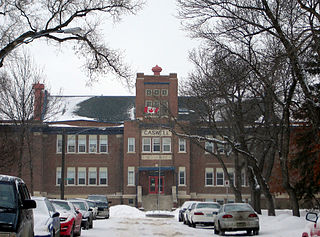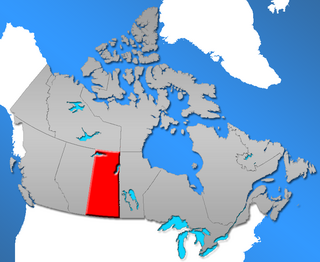Related Research Articles

Saskatchewan is a prairie and boreal province in western Canada, the only province without a natural border. It has an area of 651,900 square kilometres (251,700 sq mi), nearly 10 percent of which is fresh water, composed mostly of rivers, reservoirs, and the province's 100,000 lakes.

Prince Albert is the third-largest city in Saskatchewan, Canada, after Saskatoon and Regina. It is situated near the centre of the province on the banks of the North Saskatchewan River. The city is known as the "Gateway to the North" because it is the last major centre along the route to the resources of northern Saskatchewan. Prince Albert National Park is located 51 km (32 mi) north of the city and contains a huge wealth of lakes, forest, and wildlife. The city itself is located in a transition zone between the aspen parkland and boreal forest biomes. Prince Albert is bordered by the Rural Municipality of Prince Albert No. 461, of which it is the seat but remains politically independent, and the Rural Municipality of Buckland No. 491.

Melville is a small city in the east-central portion of Saskatchewan, Canada. The city is 145 kilometres (90 mi) northeast of the provincial capital of Regina and 45 kilometres (28 mi) southwest of Yorkton. Melville is bordered by the rural municipalities of Cana No. 214 and Stanley No. 215. Its population at the 2016 census was 4,562, making it Saskatchewan's smallest city. It is also home of hockey's Melville Millionaires who compete in the Saskatchewan Junior Hockey League and baseball's Melville Millionaires who compete in the Western Canadian Baseball League.

Humboldt is a city in the province of Saskatchewan, Canada. It is located 113 km east of Saskatoon at the junction of Highway 5 and Highway 20. The city is surrounded by the Rural Municipality of Humboldt No. 370.

Rosetown is a town in the Canadian province of Saskatchewan, at the junction of provincial Highway 7 and Highway 4, approximately 115 km southwest of Saskatoon.
The Gabriel Dumont Institute of Native Studies and Applied Research Inc. (GDI) was formally incorporated as a non-profit corporation in 1980, to serve the educational and cultural needs of the Saskatchewan Métis and Non-Status Indian community. The Institute is designated as the official education arm of the Métis Nation—Saskatchewan (MN-S). GDI offers a variety of accredited educational, vocational, and skills training opportunities for the province's Métis in partnership with the University of Regina, the University of Saskatchewan, the Saskatchewan Institute of Applied Science and Technology, the province's various regional colleges, and Service Canada.

Punnichy is a village in the Canadian province of Saskatchewan. It is approximately seventy-nine miles northeast of Regina. This town is part of the original "Alphabet Line" of the main Canadian National Railway line with Lestock to the east and Quinton to the west. Punnichy derived its name from panacay, "fledgling bird with few feathers", a Saulteaux joke referring to the appearance of a pioneer merchant.

Highway 5 is a major highway in the Canadian province of Saskatchewan. It begins in downtown Saskatoon and runs eastward to the Manitoba border near Togo, where it becomes Provincial Road 363. The highway is approximately 393 kilometres (244 mi) long. Between the early 1900s (decade) and 1976, Provincial Highway 5 was a trans-provincial highway travelling approximately 630 kilometres (390 mi) in length. At this time it started at the Alberta border in Lloydminster and traveled east to the Manitoba border.
The Rural Municipality of Canwood No. 494 was firstly formed as Rural Municipality (RM) Thompson No. 494 from January 1, 1913 until April 29, 1916 before changing names to Canwood No. 494. It is located in the north central region of the province of Saskatchewan, west of Prince Albert, and completely surrounds the First Nations Indian Reserve of Ahtahkakoop No. 104, as well as partially surrounding the First Nations Indian Reserve of Mistawasis No. 183 and the RM of Big River No. 118.

Central Alberta is a region located in the Canadian province of Alberta.
Highway 8 is a highway in the Canadian province of Saskatchewan. It runs from North Dakota Highway 28 at the US border near Elmore until it transitions into Highway 982 just outside the Porcupine Provincial Forest. Highway 8 is about 410 km (255 mi) long.

Education in Saskatchewan, Canada, teaches a curriculum of learning set out by the Government of Saskatchewan through the Ministry of Education. The curriculum sets out to develop skills, knowledge and understanding to improve the quality of life. On June 22, 1915, Hon. Walter Scott, Premier and Minister of Education, set out as his mandate the "purpose of procuring for the children of Saskatchewan a better education and an education of greater service and utility to meet the conditions of the chief industry in the Province, which is agriculture". Education facilitates the cultural and regional socialization of an individual through the realisation of their self-potential and latent talents. Historically, the region of Saskatchewan needed successful homesteaders so the focus was to develop a unified language for successful economic trading, and agricultural understanding to develop goods, livestock and cash crops to trade. After the mechanized advancements following the industrial revolution and World War II, the primary employment agriculture sector of farming was not as labour-intensive. Individuals focused on secondary industries such as manufacturing and construction, as well as tertiary employment like transportation, trade, finance and services. Schools became technologically more advanced and adapted to supply resources for this growing demand and change of focus.

Waldheim is a town of 1,035 residents in the rural municipality of Laird No. 404, in the Canadian province of Saskatchewan, located 57 km north of Saskatoon. Waldheim is located on Highway 312 in central Saskatchewan, the "Heart of the Old Northwest". Fort Carlton, Batoche, Battle of Fish Creek, and Seager Wheeler's Maple Grove Farm are all near Waldheim.
Transportation in Saskatchewan is the movement of people and goods from one place to another within the province. Transportation in Saskatchewan includes an infrastructure system of roads, highways, freeways, airports, ferries, pipelines, trails, waterways and railway systems serving a population of approximately 1,003,299 inhabitants year-round. It is funded primarily with local, rural municipality and federal government funds.
80% of traffic is carried on our principal system of highways which is 5,031 km in length.

Historically, Saskatchewan's higher education system has been "significantly shaped" by demographics. In 1901, six years prior to the 1907 founding of a university in Saskatchewan, the urban population in Saskatchewan was 14,266 (16%) while the rural population was 77,013 (84%). One hundred years later, the proportions had changed significantly: urban population in 2001 was 629,036 (64%) while the rural population was 349,897 (36%). Over time the province's higher education system has changed significantly in response both to this demographic shift and to provincial politics.

Kelly Block is a Canadian politician who was elected to represent the electoral district of Carlton Trail—Eagle Creek in the 2008 Canadian federal election. Prior to her election to the House of Commons, Block served two terms as mayor of Waldheim, Saskatchewan. Block was Waldheim's first female mayor, and also served as chairperson of the Gabriel Springs Health District. Block was later appointed to the Saskatoon Regional Health Authority when the government of Saskatchewan amalgamated its health districts. Block ran unsuccessfully for the Saskatchewan Party nomination for the provincial Martensville constituency by-election in November 2006 against Nancy Heppner.
51°25′N104°15′W

Rosthern No. 403 is a rural municipality in the Canadian province of Saskatchewan, located in the Census Division 15, just north of the City of Saskatoon, in the Central region of the province. The seat of the municipality is located in the Town of Rosthern.
Southeast College is a publicly funded regional college with six campuses in the southeast of the province of Saskatchewan, Canada. The college was created under the Regional Colleges Act of Saskatchewan. Its head office is located in Weyburn. The six campuses are located in Weyburn, Estevan, Moosomin, Assiniboia, Whitewood and Indian Head.